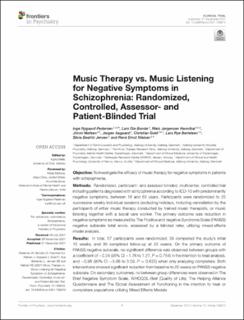| dc.contributor.author | Pedersen, Inge Nygaard | |
| dc.contributor.author | Bonde, Lars Ole | |
| dc.contributor.author | Hannibal, Niels | |
| dc.contributor.author | Nielsen, Jimmi | |
| dc.contributor.author | Aagaard, Jørgen | |
| dc.contributor.author | Gold, Christian | |
| dc.contributor.author | Rye Bertelsen, Lars | |
| dc.contributor.author | Jensen, Silvia Beatriz | |
| dc.contributor.author | Nielsen, René E. | |
| dc.date.accessioned | 2023-09-15T07:57:19Z | |
| dc.date.available | 2023-09-15T07:57:19Z | |
| dc.date.created | 2022-01-18T15:05:18Z | |
| dc.date.issued | 2021 | |
| dc.identifier.citation | Frontiers in Psychiatry. 2021, 12 . | en_US |
| dc.identifier.issn | 1664-0640 | |
| dc.identifier.uri | https://hdl.handle.net/11250/3089639 | |
| dc.description.abstract | Objective: To investigate the efficacy of music therapy for negative symptoms in patients with schizophrenia. Methods: Randomized, participant- and assessor-blinded, multicenter, controlled trial including patients diagnosed with schizophrenia according to ICD-10 with predominantly negative symptoms, between 18 and 65 years. Participants were randomized to 25 successive weekly individual sessions (excluding holidays, including cancellation by the participant) of either music therapy conducted by trained music therapists, or music listening together with a social care worker. The primary outcome was reduction in negative symptoms as measured by The Positive and negative Syndrome Scale (PANSS) negative subscale total score, assessed by a blinded rater, utilizing mixed-effects model analysis. Results: In total, 57 participants were randomized; 39 completed the study's initial 15 weeks, and 30 completed follow-up at 25 weeks. On the primary outcome of PANSS negative subscale, no significant difference was observed between groups with a coefficient of −0.24 (95% CI −1.76 to 1.27, P = 0.754) in the intention to treat analysis, and −0.98 (95% CI −5.06 to 3.09, P = 0.625) when only analyzing completers. Both interventions showed significant reduction from baseline to 25 weeks on PANSS negative subscale. On secondary outcomes, no between group differences were observed in The Brief Negative Symptom Scale, WHOQOL-Bref (Quality of Life), The Helping Alliance Questionnaire and The Global Assessment of Functioning in the intention to treat or completers populations utilizing Mixed Effects Models. Conclusion: No difference between groups randomized to music therapy vs. musical listening was observed resulting in no clear recommendation for which intervention to use as the first choice for treatment of patients diagnosed with schizophrenia and predominantly having negative symptoms. | en_US |
| dc.language.iso | eng | en_US |
| dc.rights | Navngivelse 4.0 Internasjonal | * |
| dc.rights.uri | http://creativecommons.org/licenses/by/4.0/deed.no | * |
| dc.title | Music Therapy vs. Music Listening for Negative Symptoms in Schizophrenia: Randomized, Controlled, Assessor- and Patient-Blinded Trial | en_US |
| dc.title.alternative | Music Therapy vs. Music Listening for Negative Symptoms in Schizophrenia: Randomized, Controlled, Assessor- and Patient-Blinded Trial | en_US |
| dc.type | Peer reviewed | en_US |
| dc.type | Journal article | en_US |
| dc.rights.holder | © 2021 Pedersen, Bonde, Hannibal, Nielsen, Aagaard, Gold, Rye Bertelsen, Jensen and Nielsen | en_US |
| dc.description.version | publishedVersion | en_US |
| cristin.ispublished | true | |
| cristin.fulltext | original | |
| cristin.qualitycode | 1 | |
| dc.identifier.doi | 10.3389/fpsyt.2021.738810 | |
| dc.identifier.cristin | 1983803 | |
| dc.source.journal | Frontiers in Psychiatry | en_US |
| dc.source.volume | 12 | en_US |
| dc.source.pagenumber | 0 | en_US |

